Bigotry: The Dark Danger
The Evolution Impasse 2
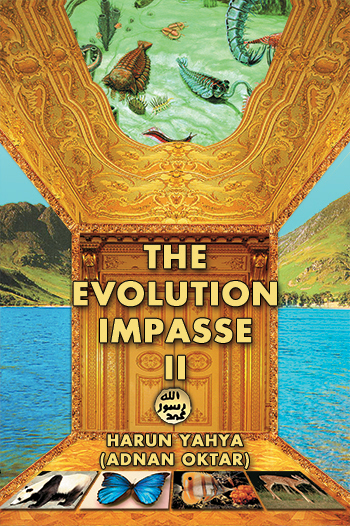
< <
8 / total: 13
S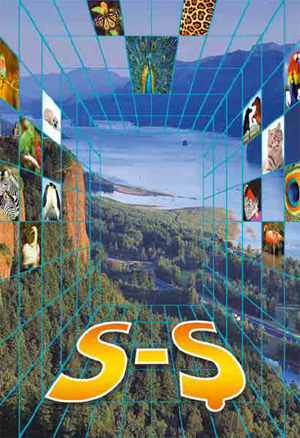 Schindewolf, OttoOtto Schindewolf, a European paleontologist, is known for the “Hopeful Monster” theory he proposed in the 1930s. 208 (See The Hopeful Monster Fantasy.) Schindewolf suggested that living things evolved through sudden and giant mutations, rather than by the small step-by-step mutations advocated by neo-Darwinists. As an example of his theory, Schindewolf claimed that the first bird in history emerged from a reptile egg through a gross mutation—a giant, random mutation in its genetic structure. According to the theory, certain large terrestrial animals might have suddenly turned into whales as a result of sudden and comprehensive changes. Schindewolf’s fantastical theory was later adopted in the 1940s by the geneticist Richard Goldschmidt of Berkeley University. Yet so inconsistent was the theory that it was swiftly abandoned.209 Second Law of Thermodynamics (The Law of Entropy)The Second Law of Thermodynamics states that left to themselves and abandoned to natural conditions, all systems in the universe will move towards irregularity, disorder and corruption in direct relation to the passage of time. This is also known as the Law of Entropy. In physics, entropy is a measurement of the irregularity within a system. A system’s passage from a regular organized and planned state to an irregular, disordered and unplanned one increases that system’s entropy. This means that the more irregularity in a system, the higher its level of entropy. 
If you abandon a car to natural conditions, it will age, rust and decay. In the same way, in the absence of a conscious order, all systems in the universe tend towards chaos. This is an inescapable law of nature. This is something we all observe during the course of our daily lives. For example, if you leave a car in the desert and go back to it some months later, of course you can’t expect it to have become more advanced and better maintained. On the contrary, you will find the tires have gone flat, the windows are cracked, the metalwork has rusted and the battery is dead.. Or if you leave your home to its own devices, you will see that it becomes untidier and dustier with every passing day. That process can be reversed only by conscious intervention—by your tidying and dusting it. The Second Law of Thermodynamics, or the Law of Entropy, has been definitively proven by theory and experiment. Albert Einstein, described it as the first law of all the sciences. In his book Entropy: A World View, the American scientist Jeremy Rifkin says: The Entropy Law will preside as the ruling paradigm over the next period of history. Albert Einstein said that it is the premier law of all science: Sir Arthur Eddington referred to it as the supreme metaphysical law of the entire universe. 210 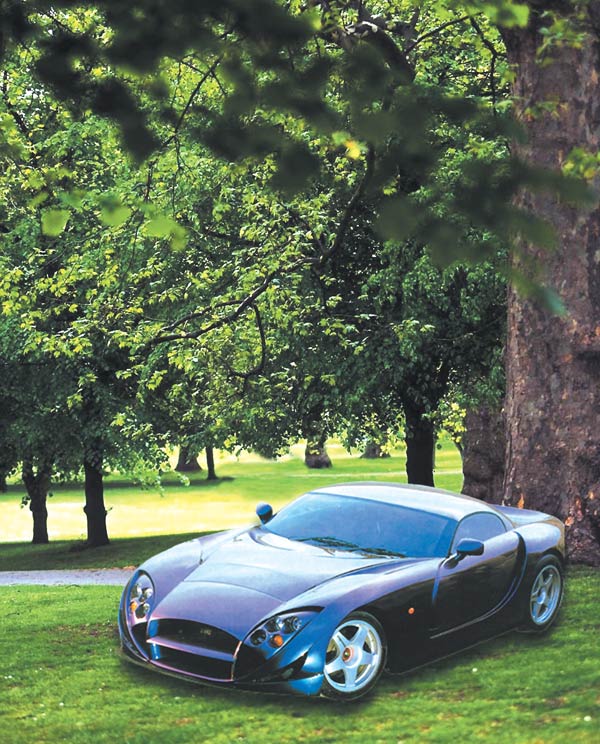
You can not think of a high-end car that you find among trees to be the out come of the randomly coming to gether of the various elements in the forest in millions of years. Since the sudden and perfect appearance of a complex structure is a sign that it is created by a conscious will power. The Law of Entropy definitively invalidates the materialist view that the universe is an assembly of matter closed to all forms of supernatural intervention. There is evident order in the universe, although the universe’s own laws should work to corrupt that order. From this, two conclusions emerge: 1) The universe has not, as materialists suggest, existed for all time. Were that the case, the Second Law of Thermodynamics would long ago have done its work, and the universe would have become a homogeneous collection of matter with no order to it at all. 2) The claim that after the Big Bang, the universe took shape with no supernatural intervention or control is also invalid. In the universe that initially emerged in the wake of the Big Bang, only chaos ruled. Yet the level of order in the universe increased, and the universe eventually attained its present state. Since this took place in violation of the law of entropy, the universe must have been ordered by way of a supernatural creation. The order in the universe reveals the existence of Allah, sublime ruler of the universe. The Nobel Prize-winning German physicist Max Planck describes this order: At all events we should say, in summing up, that, according to everything taught by the exact sciences about the immense realm of nature in which our tiny planet plays an insignificant role, a certain order prevails—one independent of the human mind. Yet, in so far as we are able to ascertain through our senses, this order can be formulated in terms of purposeful activity. There is evidence of an intelligent order of the universe. 211 Materialism, which maintains that the universe has existed for ever and has never been ordered in any way, is today in an impasse in the face of the universe’s great equilibrium. The well-known British physicist Paul Davies says: Everywhere we look in the Universe, from the far-flung galaxies to the deepest recesses of the atom, we encounter order. . . Central to the idea of a very special, orderly Universe is the concept of information. A highly structured system, displaying a great deal of organised activity, needs a lot of information to describe it. Alternatively, we may say that it contains much information. 
In order for the energy in a car's fuel to be converted, there is a need for transmission systems and control mechanisms to operate them, is because energy entering a system from the outside is not enough to make that system an ordered, efficient one. We are therefore presented with a curious question. If information and order always has a natural tendency to disappear, where did all the information that makes the world such a special place come from originally? The Universe is like a clock slowly running down. How did it get wound up in the first place? 212 Einstein said that the order in the universe was something unexpected and stated that it needed to be regarded as a miracle: Well, a priori one should expect that the world would be rendered lawful [obedient to law and order] only to the extent that we [human beings] intervene with our ordering intelligence... [But instead we find] in the objective world a high degree of order that we were a priori in no way authorized to expect. This is the “miracle” that is strengthened more and more with the development of our knowledge.213 The order in the universe, which contains such enormous information, was brought into being by a supreme Creator and Lord of the universe. To put it another way, Allah has created and ordered the entire universe. “Selfish Gene” Theory, TheThe altruistic behavior seen in living things cannot be explained by evolutionists. (See Altruism.) For example, male and female penguins defend their offspring literally to the death. The male penguin keeps its young chick between its feet for an uninterrupted period of four months, eating nothing during that time. Meanwhile, the female penguin swims through the sea hunting for food for her offspring, and carries what she finds in her craw. Such altruistic behavior, of which a great many examples can be seen in nature, undermines the fundamental premise of the theory of evolution. 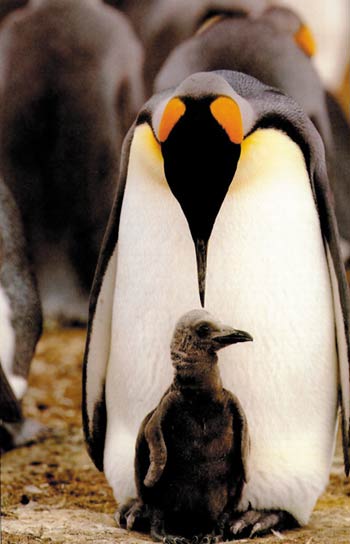
Male and female penguins defend their offspring literally to the death. . Suchal truistic behavior, of which a great many examples can be seen in nature, under mines the fundamental premise of the theory of evolution. Indeed, the well-known evolutionist Stephen Jay Gould describes “the vexatious problem of altruism”214 in nature. The evolutionist Gordon Rattray Taylor writes that the altruistic behavior in living things “has long presented a challenge for Darwinism,” 215 making it clear what a dilemma evolutionists face in the area. Nature contains instances of altruism and affection, which are completely non-material values, which deals a mortal blow to the materialist view that sees all of nature as random interactions of matter. However, unwilling to admit the invalidity of evolutionary scenarios, some evolutionists came up with the so-called Selfish Gene Theory. According to this claim, whose leading proponent was Richard Dawkins, one of the most avid present-day proponents of evolution, behavior that appears to be altruistic actually stems from selfishness, in exhibiting altruistic behavior, animals are actually thinking of preserving their genes rather than of helping another living thing. In sacrificing her own life for that of her offspring, a mother is actually protecting her own genes. If her offspring survive, there will be a greater chance of her genes being handed on to the subsequent generations. According to this perspective, all living things, human beings included, are gene machines. And every living thing’s most important task is to be able to hand on its genes to later generations. Evolutionists say that living things are programmed to continue their own bloodlines and to wish to pass on their genes, and so behave in a manner appropriate to that programming. The following quote is an example of the classic evolutionist account of animal behavior: What could account for potentially self-destructive behavior? At least some altruistic acts are reputed to stem from so-called selfish genes. Parents that work themselves ragged to feed insatiable offspring or go without food as long as a predator is near are probably carrying out genetically programmed behavior—behavior that increases the chances of parental genes within the offspring being passed on to yet another generation. These innate, instinctive responses to predators may seem “purposeful” to the human observer, but in fact they are behavioral programs triggered by sights, sounds, odors, and other cues. 216 Consequently, evolutionists say that at first sight, the behavior of living things may appear to be deliberate. But in fact, living things engage in such behavior unconsciously, not in a manner directed towards a particular objective, but because they are programmed to do so. Yet the genes proposed as the source of this programming consist of coded packages of information, with no ability to think. Therefore, if an animal’s genes possess an instruction that predisposes it to altruistic behavior, then the source of that instruction cannot be the gene itself. That a living thing is programmed to engage in altruistic behavior to transmit its genes on to subsequent generations clearly shows the existence of a Power possessed of reason and knowledge to program those genes in such a way, and therefore clearly demonstrates the existence of Allah. Self-Ordering Error, TheEvolutionist claims and concepts are generally employed in a deceptive manner. One of these misrepresentations is the deliberate confusion of the concepts of “ordered” and “organized.” To clarify this, imagine a long, straight stretch of sand along the seaside. The wind produces sand dunes large and small. This is an ordering process. Yet that same wind cannot make a sandcastle. If you see a sandcastle, you can be are sure that somebody has made it, because a castle is an organized system, possessing information organized in a specific form. It has been made by someone with advanced planning. Complex and organized systems can never come about through natural processes. Even if simple ordering does occur from time to time, this never exceeds certain specific bounds. Yet evolutionists say that self-ordering phenomena emerging spontaneously as a result of natural process are significant evidence of evolution and are examples of self-organization. (See The Self-Organization Nonsense.) They then suggest that living systems can come into being as a result of natural phenomena and chemical reactions. But while ordered systems feature simple sequences and repeated structures, organized systems contain exceedingly complex and inter-related structures and processes. Consciousness, information and organization are essential for them to emerge. This important difference is described by the evolutionist scientist Jeffrey Wicken: “Organized” systems are to be carefully distinguished from “ordered” systems. Neither kind of system is “random,” but whereas ordered systems are generated according to simple algorithms and therefore lack complexity, organized systems must be assembled element by element according to an external “wiring diagram” with a high information content . . . Organization, then, is functional complexity and carries information. 217 In their book The Mystery of Life’s Origin, the American scientists Thaxton, Bradley and Olsen clarify the issue: The widespread recognition of the severe improbability that self-replicating organisms could have formed from purely random interactions has led to a great deal of speculation—speculation that some organizing principle must have been involved. In the company of many others, Crick has considered that the neo-Darwinian mechanism of natural selection might provide the answer. An entity capable of self-replication is necessary, however, before natural selection can operate. Only then could changes result via mutations and environmental pressures which might in turn bring about the dominance of entities with the greatest probabilities of survival and reproduction. The weakest point in this explanation of life's origin is the great complexity of the initial entity which must form, apparently by random fluctuations, before natural selection can take over. 218 “Self-Organization” Nonsense, TheEvolutionists use the concept of self-organization to claim that inanimate matter can so organize itself as to produce a living entity. This belief flagrantly ignores all experiments and observations that have shown that matter possesses no such ability. Sir Fred Hoyle, the famous British astronomer and mathematician, describes how matter cannot spontaneously give rise to life with an example: To press the matter further, if there were a basic principle of matter which somehow drove organic systems toward life, its existence should easily be demonstrable in the laboratory. One could, for instance, take a swimming [pool] to represent the primordial soup. Fill it with any chemicals of a non-biological nature you please. Pump any gases over it, or through it, you please, and shine any kind of radiation on it that takes your fancy. Let the experiment proceed for a year and see how many of those [vital] 2,000 enzymes have appeared … I will give the answer, and so save the time and trouble and expense of actually doing the experiment. You would find nothing at all, except possibly for a tarry sludge composed of amino acids and other simple organic chemicals.219 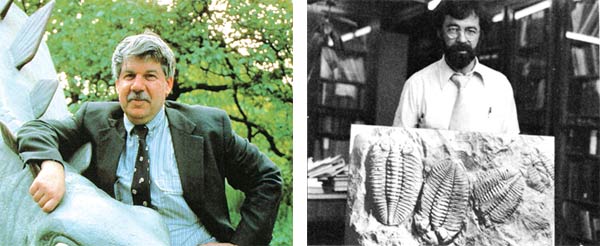
The two famous advocates of the punctuated model of evolution; Stephen Jay Gould and Niles Eldredge. The evolutionist biologist Andrew Scott admits the same thing: Take some matter, heat while stirring and wait. That is the modern version of Genesis. The “fundamental” forces of gravity, electromagnetism and the strong and weak nuclear forces are presumed to have done the rest . . . But how much of this neat tale is firmly established, and how much remains hopeful speculation? In truth, the mechanism of almost every major step, from chemical precursors up to the first recognizable cells, is the subject of either controversy or complete bewilderment. 220 Yet evolutionists insist on advocating such an unscientific scenario as the self-organization of matter. Their motive for this lies hidden in materialist philosophy, the basis of the theory of evolution. Materialist philosophy, accepting only the existence of matter, therefore must produce an explanation for life based on matter alone. The theory of evolution was born of that need and, no matter how much it may violate scientific findings, it is advocated solely for the sake of that requirement. Robert Shapiro, a professor of chemistry and DNA expert from New York University, describes the materialist dogma underpinning evolutionists’ belief in matter organizing itself it: Another evolutionary principle is therefore needed to take us across the gap from mixtures of simple natural chemicals to the first effective replicator [DNA or RNA]. This principle has not yet been described in detail or demonstrated, but it is anticipated, and given names such as “chemical evolution” and “self-organization of matter.” The existence of the principle is taken for granted in the philosophy of dialectical materialism, as applied to the origin of life by Alexander Oparin. 221 SeymouriaThe creature that was long proposed as the ancestor of reptiles was the extinct amphibian species Seymouria. However, it then emerged that Seymouria could not be an intermediate form, since reptiles were living on Earth 30 million years before Seymouria first appeared. The oldest Seymouria fossils date back to the Lower Permian stratum of 280 million years ago. Yet Hylonomus, the oldest known reptile species (310 million years old) and Paleothyris (300 million years old) have both been found in Early Pennsylvanian strata, dating back 330 to 315 million years.222 It is of course impossible for the ancestor of reptiles to have lived long after reptiles themselves. 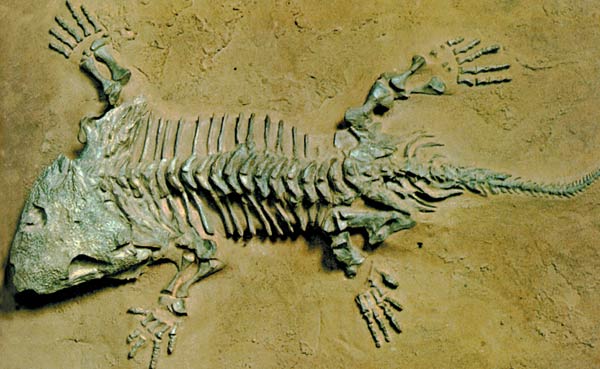
Evolutionists once claimed that the Seymouria fossil above was an intermediate form between amphibians and reptiles. According to this scenario, Seymouria was the primitive ancestor of reptiles. But subsequent fossil discoveries proved that reptiles were living on Earth 30 million years before Seymouria. This meant that evolutionists were forced to withdraw their claims regarding Seymouria. Shapiro, Robert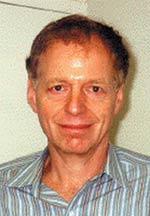
Robert Shapiro Robert Shapiro, a New York University professor of chemistry and DNA expert, calculated the probability of the 2,000 types of proteins in a simple bacterium coming into existence by chance. (The human cell contains around 200,000 different types of proteins. .) The figure obtained is a probability of 1 in 1040,000.223 (This is the astronomical figure of 1 followed by 40,000 zeroes.) A bacterium’s complexity refutes chance and clearly points to the existence of a Creator. But this evident truth is still denied because of blind devotion to the materialist world view. Robert Shapiro, a researcher into the origin of life, reveals this irrational materialist stance in these words: Similarly, the existence of bacteria and other living beings, all of which are much more complex than a watch, implies the existence of a creator, as only a higher being could design creatures so fit for their function. We will not take this escape route in our book, for we are committed to seeking an answer within the realm of science . . . We must look for another solution if we wish to remain within science. 224 Sickle Cell AnemiaThe sole example of a “useful mutation” that evolutionist biologists refer to is the disease sickle cell anemia, in which the hemoglobin molecule responsible for transporting oxygen becomes deformed and changes shape. As a result, its ability to transport oxygen is seriously impaired. Victims of sickle cell anemia suffer increasing respiratory difficulties. Yet this example of mutation, discussed under blood diseases in medical textbooks, is regarded as advantageous by some evolutionist biologists. 
The shape and function of red blood cells are distorted in sickle cell anemia. Their ability to transport oxygen is thus impaired. Sufferers from this disease enjoy a partial immunity to malaria, and this is described as an evolutionary adaptation. Using that kind of inconsistent logic, one could say that the genetically lame were spared being killed in traffic accidents since they could not walk, and that lameness is a useful genetic trait.. It is clear that mutations have only destructive effects. Pierre Paul Grassé, former president of the French Academy of Sciences, compares mutations to spelling mistakes during the copying of a written text. Like spelling mistakes, mutations add no further information, but rather damage what is already there. Grassé goes on to say: Mutations, in time, occur incoherently. They are not complementary to one another, nor are they cumulative in successive generations toward a given direction. They modify what preexists, but they do so in disorder, no matter how . . As soon as some disorder, even slight, appears in an organized being, sickness, then death follow. There is no possible compromise between the phenomenon of life and anarchy [disorder]. 225 Single Cell to Multi-Cell Transition Myth, TheAccording to the evolutionist scenario, primitive single-celled organisms that came into existence by chance were the original ancestors of all living things. Over the course of time, these organisms that formed multiplied and gave rise to multi-celled organisms. 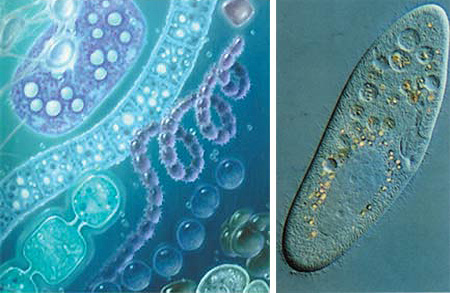
Despite being very small, bacteria possess exceedingly complex features, in terms of both structure and function. According to evolutionists, this was the first step in the passage from one cell to many. Organisms at this stage of development became genuinely multi-cellular with the division of labor among cells in their colony. Cells lost the ability to exist independently once they gave rise to multi-cellular organisms. The scenario continues thus: . At this stage of the evolutionary process, as the need to act independently decreased—or as their chances of survival improved by living as a group—, the differences between cells grew more distinct. For whatever reason, cells continued differentiating and increasing their division of labor, giving rise to increasingly multicellular organisms. At the beginning of this fantastical view lie single-celled organisms that are regarded as primitive and simple. Yet single-celled organisms are not simple life forms, as evolutionists suggest, but neither do they have the consciousness with which to make decisions and assume new duties. Single-celled organisms may have a simpler structure than multicellular ones, but by itself is not evidence that they are primitive. Indeed, although a single-celled bacterium still possesses a complexity that amazes those who investigate it. Sir James Gray, the well-known British zoologist, says this about the bacteria that Darwinists described as “simple”: A bacterium is far more complex than any inanimate system known to man. There is not a laboratory in the world which can compete with the biochemical activity of the smallest living organism. 226 The evolutionist James A. Shapiro admits that these highly detailed characteristics features make bacteria a complex form of life: Although bacteria are tiny, they display biochemical, structural and behavioral complexities that outstrip scientific description. In keeping with the current microelectronics revolution, it may make more sense to equate their size with sophistication rather than with simplicity...227 Social DarwinismOne of the theory of evolution’s most basic claims is that the development of living things is based on a struggle for survival. According to Darwin, there was a ruthless eternal conflict in nature. The strong always vanquished the weak, thanks to which progress became possible. The subtitle to his book On The Origin of Species summed up his view: By Means of Natural Selection or the Preservation of Favored Races in the Struggle for Life. Darwin’s source of inspiration on this subject was the British economist Thomas Malthus’s book An Essay on the Principle of Population, which implied a rather gloomy future for the human race. Malthus calculated that, left to itself, the human population would grow very fast, doubling every 25 years. However, food resources could not increase at nearly that quickly. The human race would therefore face a constant shortage of food. The main factors keeping population under control were such disasters as war, famine and disease. In short, some people would have to die while others lived. Survival meant constant war. Darwin admitted that he had drawn the idea of the struggle for survival in nature from Malthus: In October, 1838, that is, fifteen months after I had begun my systematic inquiry, I happened to read for amusement Malthus on population, and being well prepared to appreciate the struggle for existence which everywhere goes on from long continuous observation of the habits of animals and plants, it at once struck me that under these circumstances, favourable variations would tend to be preserved and unfavourable ones to be destroyed. The result of this would be the formation of new species. Here, then, I had at last got a theory by which to work. 228 Influenced by Malthus, Darwin applied this view to the whole of nature and suggested that in this conflict, the strongest and fittest would survive. Darwin’s claim covered all plants, animals and human beings. Moreover, he particularly emphasized that the struggle for survival was a legitimate, unchanging law. He encouraged people to abandon their religious believes by denying creation, and thus targeted all those moral criteria that might stand in the way of the ruthless struggle for survival. For that reason, Darwin’s theory acquired a great deal of support from the moment he announced it—first from the established order in Britain, and then from that in the wider Western world. The imperialists, capitalists and other materialists delighted in a theory that scientifically justified the political and social order they had established, and lost no time in supporting it. In a very short time, the theory of evolution became the sole criterion in every field of concern to human societies, from sociology to history and from psychology to politics. The basic idea in all spheres was the slogan “survival of the fittest,” and nations, political parties, administrations, businesses and individuals all began behaving in light of them. Since the ideologies that dominated society had lined up behind Darwinism, open and covert Darwinist propaganda appeared in all fields, from education to art and from politics to history. 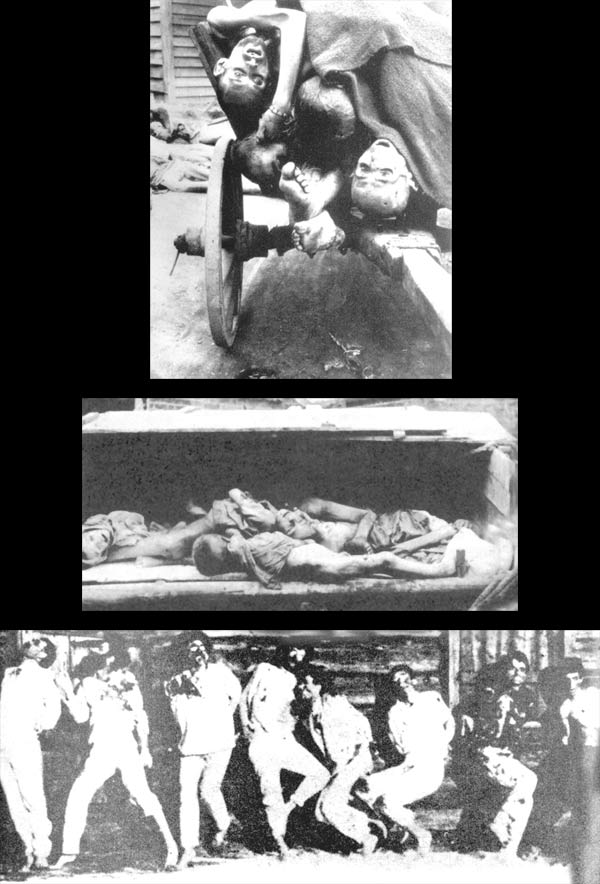
These photos reflect a very small part of the tragedies inflicted on humanity by Social Darwinism. Conflicts in the name of racism, fascism, communism or imperialism assumed a scientific guise with Social Darwinism. Conflict was claimed to exist among animals and nature, and was regarded as being inherent in human beings, too. Powerful states used this flawed logic and the slogans of Darwinism to oppress weaker nations and try to eliminate them. Attempts were made to link everything to Darwinism and to account for everything in Darwinian terms. As a result, even if people were ignorant of Darwinism, societies that lived the kind of life it foresaw began to emerge. Darwin himself approved moral conceptions based on evolution and their application to the social sciences. In a letter to H. Thiel written in 1869, he wrote: You will readily believe how much interested I am in observing that you apply to moral and social questions analogous views to those which I have used in regard to the modification of species. It did not occur to me formerly that my views could be extended to such widely different, and most important, subjects.229 With the adoption of the idea that the conflicts in nature also existed in human societies, in the forms of racism, fascism, communism and imperialism, the powerful nations’ attempts to crush those they regarded as weaker acquired a supposedly scientific justification. Those who carried out barbaric slaughter, who began wars, who denigrated others because of their race, who caused businesses to close due to unfair competition, and those who refused help the poor were now not to be criticized or restrained—because they acted in conformity with a law of nature. This new, supposedly scientific theory assumed the name of Social Darwinism. The American paleontologist Stephen Jay Gould, one of the leading present-day advocates of the theory of evolution, admits as much: Subsequent arguments for slavery, colonialism, racial differences, class struggles, and sex roles would go forth primarily under the banner of science.230 In his book Darwin, Marx, Wagner, the professor of history Jacques Barzun analyzes the scientific, sociological, and cultural reasons for the terrible moral collapse in the modern world. These comments in Barzun’s book are noteworthy in terms of Darwinism’s impact on the world: . . . in every European country between 1870 and 1914 there was a war party demanding armaments, an individualist party demanding ruthless competition, an imperialist party demanding a free hand over backward peoples, a socialist party demanding the conquest of power, and a racialist party demanding internal purges against aliens—all of them, when appeals to greed and glory failed, or even before, invoked Spencer and Darwin, which was to say, science incarnate . . . Race was biological, it was sociological, it was Darwinian. 231 Despite being an evolutionist, Robert Wright, author of The Moral Animal, summarizes the disasters that the theory of evolution inflicted on the mankind: Evolutionary theory, after all, has a long and largely sordid history of application to human affairs. After being mingled with political philosophy around the turn of the century to form the vague ideology known as “social Darwinism,” it played into the hands of racists, fascists, and the most heartless sort of capitalists. 232 Speciation—See Allopatric Isolation. Spencer, HerbertHerbert Spencer was the main theoretician of Social Darwinism, who adapted Darwin’s principles to the life of society. He wrote that if someone was poor, that was his own fault: No one should help anyone else to improve themselves. If someone is rich, even if he had acquired that wealth immorally, that was due to his own talent. Therefore, while the poor are eliminated, the rich live on. This view dominates just about all modern societies, and is the essence of capitalist morality. (See Social Darwinism.) Spencer, an advocate of that morality, completed his study entitled Social Statistics in 1850. In this he opposed all forms of state assistance, health-protection measures, state schools and compulsory vaccinations. That was because, in the view of Social Darwinism, the social order was based on the principle of the survival of the fittest. Supporting the weak and keeping them alive to propagate was a violation of that principle. The rich were rich because they were more fit, and some nations governed others because they were superior. Some nations had come under the yoke of others because the latter were more intelligent. Spencer strongly advocated the adaptation of this thesis to human societies, summing up the Social Darwinist view in these words: If they are sufficiently complete to live, they do live, and it is well they should live. If they are not sufficiently complete to live, they die, and it is best they should die. 233 Spontaneous Generation—See Abiogenesis. StasisThe fossil record shows that living species emerged in a single moment with all their different structures fully formed, and that they remained unchanged over very long geological periods of time. Had any evolution actually taken place, then living things would have appeared on Earth through gradual changes and should have continued to change. Yet the fossil records demonstrate the exact opposite. Different living classes emerged suddenly with no ancestors even remotely resembling them and remained in a state of stasis, undergoing no change at all, for hundreds of millions of years. Struggle For Survival, TheThe fundamental assumption of the theory of natural selection is that every living thing thinks only of itself in the struggle to the death. In proposing this idea, Darwin was influenced by the theories of Thomas Robert Malthus, a British economist. Malthus said that food resources increased arithmetically, while the human population increased geometrically—for which reason it was inevitable that humans should wage a constant fight for survival. Darwin applied this concept to nature and claimed that the result of this struggle wasnatural selection. Subsequent research, however, showed that there was no such struggle for survival of the kind that Darwin had postulated. Lengthy studies on animal populations in the 1960s and ’70s by the British zoologist Wynne-Edwards showed that animal communities balanced their populations in very interesting ways, to prevent competition for food. Animal communities generally regulate their populations in accordance with the available food supplies. Population is controlled not by such “eliminators of the unfit” as starvation and epidemic diseases, but by control mechanisms instinctively present in animals. In other words, animals stabilized their populations not by the life-or-death competition to the death postulated by Darwin, but by restricting their own reproduction.234 Even plants exhibited signs of self-regulation, rather than competition through natural selection as proposed by Darwin. Observations by the botanist A.D. Bradshaw proved that as plants multiplied, they behaved according to their density in the area they grew in—and that as plant numbers increased, reproduced declined.235 In addition, the examples of altruism encountered in such communities as ants and bees represent a model that is the exact opposite of Darwin’s concept of a struggle for survival. (See Altruism.) Some recent research has revealed that altruistic behavior can be found even in bacteria. These organisms have no brain or nervous system, and thus lack any ability to think. Yet when invaded by viruses, they commit suicide in order to protect other bacteria. 236 These examples invalidate the concept of the struggle for survival, which is the fundamental hypothesis of natural selection. (See Malthus, Thomas and Social Darwinism.) Synthetic Evolution Theory, The—See Neo-Darwinism Comedy, The. Systematic—See Taxonomy.
NOTES
208.http://en.wikipedia.org/wiki/Otto_Heinrich_Schindewolf
209. http://www.revelationwebsite.co.uk/index1/menton/b8.htm
210.Jeremy Rifkin, Entropy: A New World View, New York: Viking Press, 1980, p. 6.
211. Barth, A., “The Creation In the Light of Modern Science,” (1966) Jerusalem Post Press, Jerusalem, p. 144..
212. Paul Davies, The Accidental Universe, 1982, Cambridge: Cambridge University Press, Preface
213.Albert Einstein, Letters to Maurice Solovine, 1956, pp.114-115.
214. Gordon Taylor, The Great Evolution Mystery, p. 223.
216.Janet L. Hopson, Norman K. Wessells, Essentials of Biology, McGraw-Hill Publishing Company, Vol. 45, 1990, pp. 837-839.
217.Jeffrey S. Wicken, “The Generation of Complexity in Evolution: A Thermodynamic and Information-Theoretical Discussion,” Journal of Theoretical Biology, Vol. 77, April 1979, p. 349.
218. Charles B. Thaxton, Walter L. Bradley & Roger L. Olsen, The Mystery of Life’s Origin: Reassessing Current Theories, 4th edition, Dallas; 1992, p. 146..
219. Fred Hoyle, The Intelligent Universe, London: Michael Joseph, 1983, pp. 20-21.
220. Andrew Scott, “Update on Genesis,” New Scientist, Vol. 106, May 2, 1985, p. 30.
221. Robert Shapiro, Origins: A Sceptics Guide to the Creation of Life on Earth, New York:, Summit Books, 1986, p. 207.
222.http://en.wikipedia.org/wiki/Hylonomus
223. Robert Shapiro, Origins: A Skeptic's Guide to the Creation of Life on Earth, p. 127.
225. Pierre-Paul Grassé, Evolution of Living Organisms, New York: Academic Press, 1977, pp. 97-98.
226.Sir James Gray, chapter in Science Today (1961), p. 21.
227.James A. Shapiro, “Bacteria as Multicellular Organisms,” Scientific American, Vol. 258, No. 6, June 1988, p. 82.
228. Charles Darwin, The Origin of Species, Introductory Note, p.4, http://www.bartleby.com/11/101.html
229. Francis Darwin, The Life and Letters of Charles Darwin, pp. 293-294.
230. Stephen Jay Gould, The Mismeasure of Man, New York: W.W. Norton and Company, , 1981, p.72.
231. Jacques Barzun, Darwin, Marx, Wagner, Garden City, N.Y.: Doubleday, 1958, pp. 94-95, cited in Henry M. Morris, The Long War Against God, Baker Book House, 1989, p. 70.
232. Robert Wright, The Moral Animal, New York: Vintage Books, 1994, p. 7.
233. Herbert Spencer, Social Status, 1850, pp. 414-415.
234. Wynne-Edwards, V. C., “Self Regulating Systems in Populations of Animals,” Science, Vol. 147, 1965, pp. 1543-1548.
235.Lee Spetner, Not By Chance!: Shattering the Modern Theory of Evolution, New York: The Judaica Press, Inc., 1997, pp. 16-17.
236. Andy Coghlan, “Suicide Squad,” New Scientist, July 10, 1999.
|
8 / total 13
You can read Harun Yahya's book The Evolution Impasse 2 online, share it on social networks such as Facebook and Twitter, download it to your computer, use it in your homework and theses, and publish, copy or reproduce it on your own web sites or blogs without paying any copyright fee, so long as you acknowledge this site as the reference.
